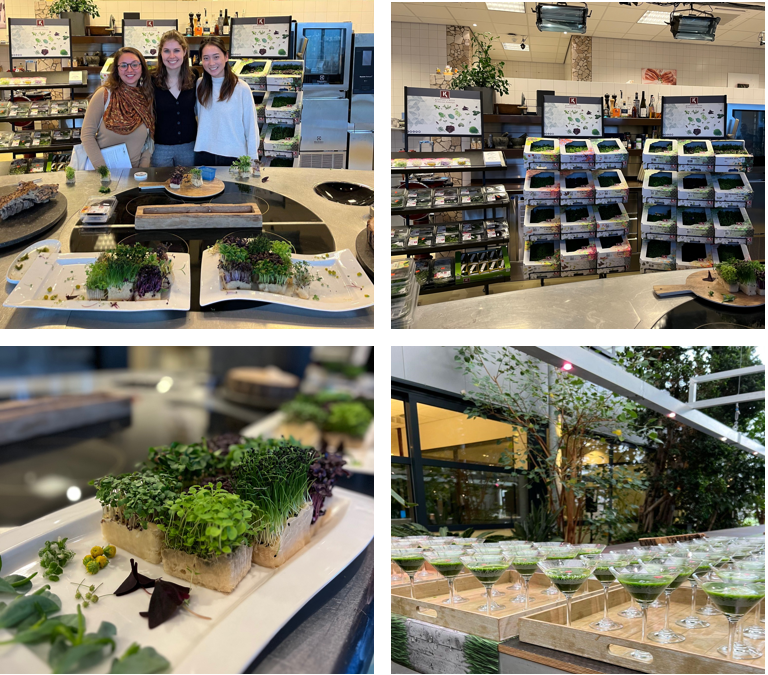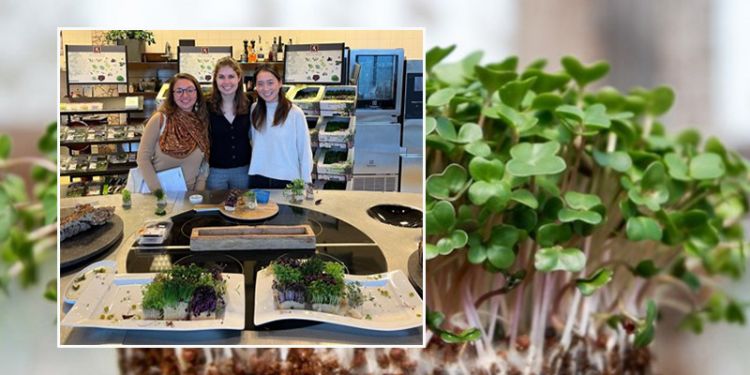In January 2023, Professors Willy Shih and Mike Toffel led more than 40 HBS MBA students on site visits to witness the energy transition and innovative sustainable production activities throughout Denmark and the Netherlands, in their new Immersive Field Course (IFC). This is one of 13 student essays posted on the HBS Business and Environment Initiative’s Blog that highlights their reflections. Learn more about this IFC course on Decarbonization and Sustainable Production by watching this five minute video summary.
Visit Date: January 12, 2023
On a cold and rainy day in January, forty-five Harvard Business School students darted between raindrops in the western Netherlands into the verdant lobby of Koppert Cress, an agricultural producer of microgreens. It was the last site visit of our Immersive Field Course (IFC) on Decarbonization and Sustainable Production, a class designed to give students first-hand exposure to pivotal technological challenges and approaches to addressing climate change across different industries, including energy, shipping, consumer products, and agriculture.
Introduction to Koppert Cress
Located in Westland, nicknamed the “Silicon Valley of Horticulture'' for its high concentration of agricultural innovation, Koppert Cress stands apart from its peers for its unique focus on gastronomy and innovative greenhouse production methods. The company was founded by Rob Baan, an ardent microgreen enthusiast. A self-described “plant hunter,” Baan doesn’t believe in foraging because of the risk it poses to rare plants, so he instead searches out natural, innovative ingredients around the world and then figures out how to propagate them in his greenhouses. Baan sells his microgreens (including cresses, leaves and edible flowers) to some of the best chefs in the world to “intensify the flavor, aroma, or presentation of their dishes.” We were fortunate enough to taste a dozen different types of Koppert Cress’s microgreens. Remarkably varied and packed with flavor, the microgreens surprised and amazed all who tried them.
Turns out Rock Chives taste like garlic, and Borage Cresses like oysters. Sechuan buttons set your mouth tingling, and Tahoon Cress undoes the effect.
It’s easy to imagine how they might be used in fine dining to dazzle and delight the palate.

Sustainable Production
Koppert Cress grows its microgreens exclusively in greenhouses, which generate higher yields per acre with significantly less water and other inputs such as fertilizers. Moreover, using greenhouses enables Koppert Cress to cultivate its products year-round. The tables in the greenhouses appeared to be less than three quarters full. When asked, Baan explained that he grows only enough to meet demand from his clients and no more. With high margins and a maximum production cycle of six weeks, Baan can afford idle capacity to be responsive to demand.
Koppert Cress has five greenhouses providing eight different climatic zones, which enable it to grow microgreens from around the world in controlled conditions. The plants themselves are grown in cellulose, which is not only highly absorbent (ideal for roots to soak up water), but is also biodegradable. The cellulose is contained in plastic trays, but the company is searching for alternative carriers to reduce their reliance on single-use plastics. Given the high energy intensity to light and heat greenhouses, the most significant determinant of their sustainability is the source of their energy. Koppert Cress uses a circular system to capture and store heat in the summer in water 150 meters below ground, which can then be used to heat the greenhouses in the winter. Heat is captured from the sun on the “energy roof,” from external water sources, and even from the LED lighting used in the greenhouses. Cold water can also be stored underground to cool down the greenhouses. The company currently uses some natural gas to supplement this circular heating/cooling system. However, by 2025, Baan plans for Koppert Cress to be completely fossil-free, compelled both by environmental and financial imperatives, given the high energy costs resulting from the Russia-Ukraine war. To enable this, Koppert Cress will begin using geothermal energy next year.

Further Sustainable Considerations
1. Vertical Farming: Koppert Cress currently grows its microgreens in a single layer. Given microgreens are inherently diminutive (no more than a few inches tall), this arrangement leaves a lot of open vertical space in Koppert Cress’s greenhouses. Baan says he has no plans to switch to vertical farming because he wants to use sunlight instead of relying solely on artificial lighting. While this practice has the admirable effect of reducing the energy Koppert Cress requires for lighting, it might be more energy intensive to regulate the temperature of larger greenhouses than to light smaller ones. Vertical farming might potentially help Koppert Cress achieve their goal of being carbon neutral.
2. Replication: Several of the innovations used in Koppert Cress’s greenhouses might be replicated by other producers, including the heat/cold storage system, energy roof, and LED lighting. However, a sufficient concentration of infrastructure, research, experience, and expertise is needed in a given area in order for a producer to maintain and repair the equipment, access the required nutrients for plants, and generally create the appropriate growing conditions to enable the operation to thrive. While Westland is far and away the leader in indoor agriculture today, in the next decade other hubs containing the needed infrastructure will hopefully begin to develop around the world. Instead of viewing this as a threat, Koppert Cress has started selling seeds to its competitors. Baan’s vision is “change the way we look at food” and for now he sees competitors as a way to grow the industry.
3. Succession: Family agricultural businesses often face threats in the transition between generations, given the waning appeal of agriculture to younger generations. Thankfully for Koppert Cress, Baan has developed a strong team and his children already work for the company. However, Baan undeniably remains the central force behind Koppert Cress, and his deep knowledge of botany, business, and gastronomy will be difficult to replicate when he steps down.
4. B2B versus B2C: Koppert Cress sells exclusively to restaurants in a B2B model. Baan prefers this segment because restaurants have lower price sensitivity and therefore Koppert Cress can maintain high margins. However, there is an open question of whether Koppert Cress will sell directly to consumers in the future, opening up a much larger, but lower margin market.

-----
Read more posts in the IFC Series:
Deconstructing LEGO’s Decarbonization
Port Esbjerg: Deploying Offshore Wind
HySynergy and Crossbridge Energy
Grundfos: Innovation & Inspiration for Sustainable Product Design
Arla Foods: How Sustainable Can A Dairy Company Be?
Amager Bakke: A Look into the Future of Waste Incineration
Maersk’s Journey to Decarbonize Shipping
BTG Bioliquids: Creating Fast Pyrolysis Bio-Oil from Biomass Residue Streams
Grolsch Brewing Company: Drink Sustainably
Van den Ende Rozen: Greenhouse Rose Production

